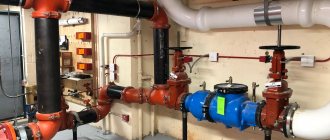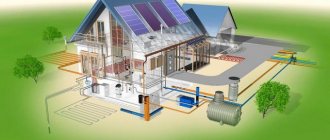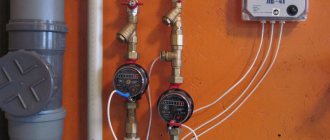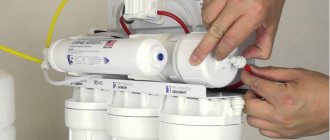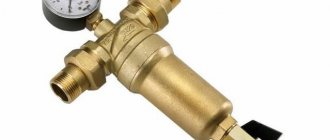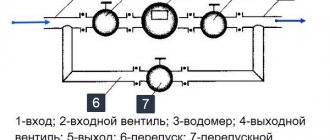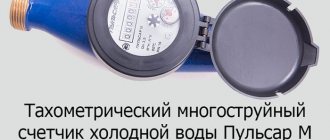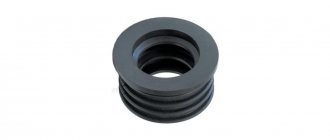Time limits for taking water meter readings
To transfer settlements to the management company, a date is selected from the 15th to the 30th of the month .
The contract with the authorized organization usually states the date of transfer of the testimony. If there are no such recommendations, then the homeowner needs to have time to transfer data from water meters in the second half of the month. Then there will be no discrepancies with accounting - everything is clear and transparent, there are no “floating” balances.
For greatest accuracy, data should be taken every month on the same date . In this case, the consumer sees real consumption on a monthly basis and can accurately plan his payment expenses.
If the homeowner for some reason does not provide evidence, then payment will be calculated based on the average consumption for the last 3 months.
You can correct the data after checking the meters by a management specialist. This check occurs once every 6 months.
If the counter is lying
To check, the meter is dismantled and taken to the laboratory
If you notice that the meter is showing false information, you should check it. The verification will be carried out at your expense. If the meter is under warranty, then the certified company that sold it will pay. During this time, you will pay for water according to your average monthly consumption. After the inspection is completed, the water meter is repaired or replaced. If you overpaid, a recalculation occurs and the overpayment amount is returned to you.
Now about the cause of the malfunction. Your guilt is determined if the seal on the meter is damaged, the glass is broken, or the arrows are missing, if a scheduled check was not done. Then you will face a fine.
How to remove data correctly?
Water measuring devices are distinguished by the color of the device body:
- cold water – blue or black meter;
- hot water - meter in a red housing.
Each device can be marked with a marker: “X” and “G”. There will definitely not be any confusion.
On a kind of “display” under the glass of the water meter there is a scale with numbers - each of them in its own window. The numbers come first in black, followed by red .
The resource supplying organization is only interested in “black” numbers. They show how many cubic meters of water were used in a given apartment. Red data is current consumption in liters, it is not taken into account.
Correct reading consists of the following steps:
- Write down the first 5 digits from the counter.
- If there are more than 500 liters on the red part of the scale, add one to the last black number.
- Readings of the red part of the dial that do not reach 500 are simply discarded.
There are meters in which the scale shows the cubic capacity of the water, and the displacement is reflected on additional round dials. There are usually 4 such dials. The leftmost one shows data that is interesting only to a specialist - the technological flow of water. The other three are hundreds, tens and units of liters.
Readings from this type of device are taken in the same way: only 5 digits of the scale are taken . They are also rounded: if you used more than 500 liters, you need to add one to the last number; if you didn’t use them, you should not take into account the displacement.
By meter
When meters are installed, readings are taken separately. Individual metering devices for cold and hot water differ in color design. For the former, the body is painted blue, for the latter – red.
Sequence of readings
The readings must be taken between the 20th and 25th of the current month, subject to the following sequence of actions:
- write down the current number of cubic meters, excluding the leading zeros and the fractional component;
- Subtract the value taken last month from the recorded value.
For further calculation, the obtained result is multiplied by the tariff size, taking into account wastewater disposal (if there is a centralized sewerage system).
The consumer must promptly submit meters for verification to a licensed organization. To do this, you must inform the resource provider about the need for this activity. The water meter will be removed and the corresponding report will be drawn up. During the time the device is being verified, payment is calculated based on the average indicators for the previous six months.
Meter readings with an overdue verification period are considered invalid.
Payment calculation
An example of a calculation for a situation similar to that indicated above, when considering determining the amount of payment according to standards. Over the course of a month, the family consumed 9 cubic meters of cold water and 2 cubic meters of hot water.
For cold water you must pay: 9 ×79.73 (tariff for cold water) = 717.57 rubles.
Payment amount for DHW: 2 × 199.84 (tariff for DHW) = 399.68 rubles.
Attention! Each region, territory or republic has different tariffs. You can find out the tariff in your area on the official website of the utility service provider or from your receipt.
As you can see, with individual metering devices installed, the bill amount will be significantly lower, especially compared to payment according to standards when using increasing factors. The use of coefficients that increase the payment amount is connected with the purpose of attracting consumers’ interest in installing water meters. In this case, the owner will pay only for the resources actually consumed.
Step-by-step instructions for calculating hot and cold water consumption in an apartment
When installing metering devices, you should inform the management company or the resource supplying organization (depending on with whom the consumption agreement is concluded) about their presence in the apartment. Afterwards you need to report the initial meter readings. These will be the first 5 digits of the black segment of the scale.
Further actions:
- The previous or initial readings are subtracted from the last readings. The resulting figure is the water consumption for a certain period in cubic meters.
- Submit current testimony to the Criminal Code in person, by phone or electronically (by e-mail).
- Multiply the number of cubic meters consumed by the tariff for 1 m3 of cold water. The result will be the amount to be paid, which, ideally, should match the amount in the receipt from the management company.
The calculation formula looks like this : NP – PP = PKV (m3) PKV X tariff = CO, where:
- NP – real indications;
- PP – previous readings;
- PKV – consumed amount of water in cubic meters;
- SO – amount to be paid.
The tariff for cold water consists of two tariffs: for water disposal and water consumption. You can find out each of them on the website of the water supply organization or your management company.
For example: a new cold water meter has been installed in the apartment. The meter scale consists of 8 digits - five on a black background and 3 on a red background. Initial readings during installation: 00002175. Of these, the black numbers are 00002. They should be transferred along with information about installing the meter to the Criminal Code.
A month later, the numbers 00008890 appeared on the counter . Of these:
- 00008 on the black scale;
- 890 – on red.
890 is a displacement exceeding 500 liters, so 1 should be added to the last digit of the black scale. Thus, in the dark sector the number 00009 is obtained. This data is transmitted to the Criminal Code.
Consumption calculation: 9-2=7. This means that over the course of a month, family members “drank and threw away” 7 cubic meters of water. Next, we multiply the quantity by the tariff, we get the amount to be paid.
The rules for hot water are similar to cold water:
- take readings (all numbers up to the red scale) from the meter;
- round the last number to one, discarding or adding liters of the red part of the scale;
- subtract the current readings from previous readings;
- multiply the resulting number by the tariff.
An example of calculation using a type 2 meter with a 5-digit scale and three displacement displays: in the receipt for last month, the latest reading of the hot water water meter is 35 cubic meters. On the day the data was taken, the scale numbers were 37 cubic meters. m.
On the rightmost dial scale the arrow points to number 2. The next display shows number 8. In the last of the measuring windows – number 4.
This means that during the time from the previous to the last reading, 2 cubic meters of hot water were consumed (37 - 35 = 2).
In liters consumed:
- 200 liters, according to the first dial (it shows hundreds);
- 80 liters - according to the second (shows tens);
- 4 liters is the reading of the third scale, which shows units.
In total, during the billing period, hot water consumption amounted to 2 cubic meters. m. and 284 liters. Since 284 liters is less than 0.5 cubic meters of water, this figure should simply be discarded.
When transferring data to Vodokanal or Management Company, indicate the last reading - 37. To find out the amount to be paid, multiply the number by the tariff.
IT IS IMPORTANT TO KNOW
- The presence of a meter does not exempt you from paying general house overspending.
In accordance with the Decree of the Government of the Russian Federation, the recalculation formula is as follows. General house water consumption according to measurement indicators is divided by the volume of water according to consumption standards + indicators of apartment meters. The resulting coefficient is multiplied by the water consumption according to the apartment meter and the established tariff. Payments made for water are deducted from this amount. This is the amount that will be in the “recalculation” column in the receipt.- If you are absent and do not use water (you went on vacation, went to a sanatorium, were guests, were hospitalized), upon your return you can apply for a recalculation by providing a document confirming your absence (tickets, voucher, extract from the clinic). This function is only available for apartments WITHOUT meters.
- The presence of people with disabilities does not affect the amount of payment in any way. Their refund is added to their pension.
The cost in the invoice from the management company differs from that calculated independently: how to figure it out?
You need to start by checking the latest and previous readings with the Criminal Code. The calculations on receipts are done by a computer program, but the data is entered into it by a company employee. The human factor has not been canceled - an error can creep in at any stage.
If the readings of the homeowner and the settlement organization coincide, then the following reasons for the discrepancy are possible:
- The tariff for cold and/or hot water has changed.
- When calculating the cost of water, the owner took into account only water consumption, omitting/not noticing the tariff for sewerage.
- A household or apartment is charged more than the required amount of water for general household needs.
It is best to contact the Criminal Code with a statement indicating the latest water meter readings. The statement may contain a request for clarification or, if the owner is confident that he is right, a request for recalculation and return of money.
According to the standard
In the absence of a water meter, payment for water supply is charged based on calculated standards - experimentally established volumes of consumption during the month. In the Russian Federation, standards differ depending on the region, since their approval is the responsibility of regional authorities.
The owner can find out the standard established in the region and the size of the tariff rate by going to the website of the State Information System or the portal of local authorities. An alternative way is to contact the management company with questions.
Calculation of fees according to the standard is possible under the following circumstances:
- There is no meter installed in the apartment or private house. If in this situation the owner has not documented the lack of technical ability to install a meter, the payment is calculated using an increasing factor of 1.5;
- for apartments and private households equipped with an individual metering device, provided that the owner does not provide information about consumed resources for the previous 3 months. The increasing factor is not applied in this case;
- in the situation described above, the meter became unusable due to a malfunction or the expiration of the next verification period, with an increasing factor of 1.5.

